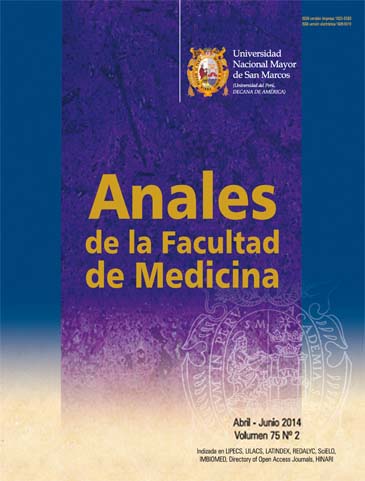Association of dietary habits and nutritional status with socioeconomic status of older adults attending a Municipal Program
DOI:
https://doi.org/10.15381/anales.v75i2.8382Keywords:
Older adults, nutritional status, dietary habits, socioeconomic status, MunicipalityAbstract
Background: The population of older adults has been increasing in the country. Addressing their problems is complex. They are considered a risk group, with health and nutrition problems related to socioeconomic and other factors. Objectives: To determine the association of dietary habits and nutritional status with socioeconomic status (SES) in older adults attending a Municipal Program. Design: Descriptive, cross-sectional association study. Setting: Municipal Program for Older Adults of 4 districts in Metropolitan Lima, Peru. Participants: Adults over 60 years of both sexes. Interventions: Weight and height were determined, and previously validated surveys on dietary habits and socioeconomic status were applied to 115 subjects who constantly attended a Municipal Program. Main outcome measures: Nutritional status according to body mass index, adequacy of eating habits according to recommendations, and socioeconomic status by Graffar's scale. Results: Overweight and obesity prevalence were respectively 42.6% and 19.1%. Over 60% had inadequate dietary habits regarding meat (65.2%), dairy (78.3%), beans (87.8%), fruits and vegetables (64.3%). Older adults were located mainly on the medium-low SES (37%) and medium-medium SES (33%). Nutritional status was not significantly associated with SES (p = 0.629). Dietary habits were significantly associated (P <0.05) with SES in the consumption of meat (p=0003), cereals and tubers (p=0038), and fruits and vegetables (p=0001). Conclusions: An association of food habits with SES but not with nutritional status was found in our study subjects.Downloads
Published
2014-06-16
Issue
Section
Trabajos originales
License
Copyright (c) 2014 Fiorella Sánchez Ruiz, Flor De la Cruz Mendoza, María Cereceda Bujaico, Sissy Espinoza Bernardo

This work is licensed under a Creative Commons Attribution-NonCommercial-ShareAlike 4.0 International License.
Those authors who have publications with this magazine accept the following terms:
- Authors will retain their copyrights and guarantee the journal the right of first publication of their work, which will be simultaneously subject to Creative Commons Attribution License that allows third parties to share the work as long as its author and its first publication this magazine are indicated.
- Authors may adopt other non-exclusive licensing agreements for the distribution of the version of the published work (eg, deposit it in an institutional electronic file or publish it in a monographic volume) provided that the initial publication in this magazine is indicated.
- Authors are allowed and recommended to disseminate their work over the Internet (eg: in institutional telematic archives or on their website) before and during the submission process, which It can produce interesting exchanges and increase quotes from the published work. (See El efecto del acceso abierto ).
How to Cite
1.
Sánchez Ruiz F, De la Cruz Mendoza F, Cereceda Bujaico M, Espinoza Bernardo S. Association of dietary habits and nutritional status with socioeconomic status of older adults attending a Municipal Program. An Fac med [Internet]. 2014 Jun. 16 [cited 2025 Jun. 5];75(2):107-11. Available from: https://revistasinvestigacion.unmsm.edu.pe/index.php/anales/article/view/8382



